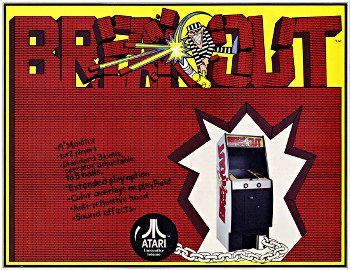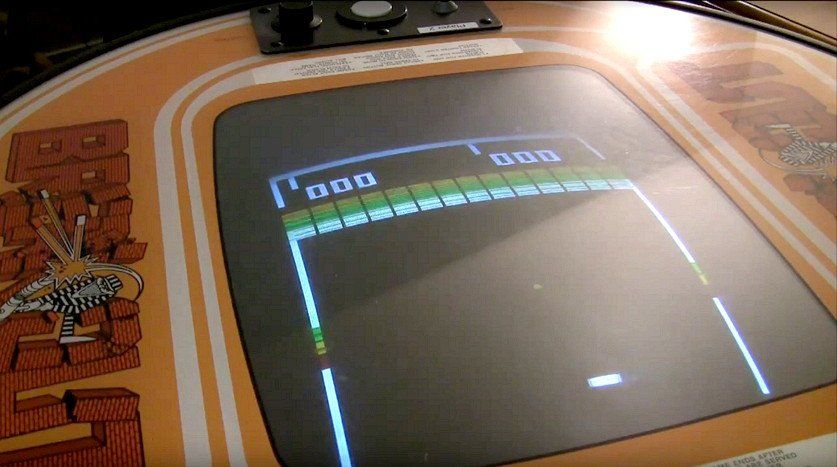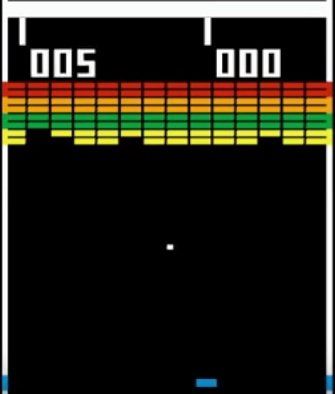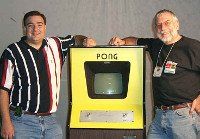Game History
Breakout
Publisher/Manufacturer: AtariGameplay Conception: Nolan Bushnell/Steve BristowRelease Year: 1976
By Mike Stulir • Vice President, The American Classic Arcade Museum
ACAM’s game of the month for May, 2016 has a very interesting history for several different reasons. Breakout recently celebrated its 40th anniversary, so this is a perfect time to take a close look at the development, history and legacy of one of Atari’s earliest games. The story of Breakout cannot be fully told without looking at the people that had a major hand in its creation; an aspiring electronics engineer names Steve Wozniak & Atari technician Steve Jobs.
You probably recognize those names as the co-founders of Apple Computer.
When the name Steve Jobs is mentioned to people today, he is thought of as a revered visionary that founded Apple Computer. However, Jobs was an interesting character….one that tended to be harsh to those around him and one that some experts feel gets entirely too much credit for Apple Computer. The creation of Breakout is no different.
After graduating from high school, Steve Jobs attended Reed College in Portland, Oregon in the fall of 1972. He only made it through about six months of coursework before dropping out & essentially, being homeless for over a year. Many people referred to Jobs lifestyle during that period as being like a “hippie,” and his minimalist lifestyle & long unkempt hair contributed to that feeling. In his 2005 Stanford University commencement address, Jobs said that during this period, he slept on the floor in the dorm rooms of his friends, collected & recycled soda bottles for cash & got free meals from a temple of Hare Krishna followers.
He moved back to California & immediately started looking for work that would finance a trip he wanted to make to India to study Zen Buddhism. Jobs started at Atari 1974. Al Alcorn, the designer of Pong, was the manager that interviewed Jobs. It has been believed that Jobs exaggerated his skillset and outright lied about prior employment at Hewlett Packard. Despite this, Jobs was hired as employee #40, and immediately started rubbing the other employees the wrong way. Jobs was known for being arrogant to the point of not getting along with his co-workers and frequently preaching his religious beliefs. In his 2011 speech at the Game Developers Conference, Atari founder Nolan Bushnell stated “Steve was about to be fired because he didn't work well with others. So I said, 'I will put you on the engineering night shift,' which we didn't actually have, but I felt that no matter how prickly someone was, it was worth working around. He was eventually put on night shift to minimize his contact with other employees.”
Jobs was focused on finding a way to take his trip to India. He eventually convinced Atari management to fund his trip if he made a stop in West Germany to fix electrical issues in Atari coin-op games that had been delivered to that country. Shortly before leaving on that trip, Atari management became familiar with a friend of Steve Jobs named Steve Wozniak. “Woz” as he is commonly referred to, had created a homebrew version of the Pong coin-op. At the same time, Atari was developing the Atari home Pong console & was very interested in the design that Woz came up with. Atari offered him a job which he turned down because he loved the work he was doing for Hewlett Packard.
Jobs returned from India in 1975 and was re-hired by Atari. During the time Jobs was in India, the Atari home Pong console hit the market and was an immediate success. Upon his re-hire, Jobs volunteered to take on a project he had no skills to complete & that no other Atari engineer was willing to do. Nolan Bushnell & VP of Engineering Steve Bristow, had an idea to make a single player game based off of the gameplay elements of Atari’s first coin-op arcade hit, Pong. The game would involve batting a ball against rows of bricks. The game would eventually be known as Breakout.
Bushnell & Bristow envisioned multiple rows of bricks. Points were awarded by knocking down as many colored bricks down as possible by deflecting or rebounding a ball against the wall with your paddle. The game is presented on a traditional black & white monitor with a colored gel screen overlay to simulate several colors over the bricks. To make the game more challenging, the speed of the game increases as you knock down more and more bricks. The paddle decreases by half the size when the red row is broken through.
Breakout cocktail cabinet
Atari’s engineers felt the arcade world was moving away from “ball and paddle” games and did not want to create this game. With no one stepping up to the plate except for Jobs, Bushnell & Bristow gave him the project despite knowing Jobs was not capable of finishing the task. The only reason Bushnell & Bristow gave the task to Jobs was because Jobs said he would do it with the assistance of Steve Wozniak… a name they immediately remembered.
Jobs convinced Woz to help him on the project, but did it via very underhanded means. Jobs was to be given a designers bonus of $700, which he told Woz he would split with him. During this time, circuitry was very expensive. Atari offered additional bonuses for hardware design that reduced the amount of integrated circuits to a minimum…..a fact that Jobs elected to keep to himself. Atari already had a basic design for Breakout that used over 100 chips. That amount of chips would have made manufacturing and sale of the game prohibitively expensive. Reducing the amount of chips was the only way to get the game on to the market.
Over the course of several days, Jobs & Woz worked around the clock and came up with a circuit design for Breakout. Woz did the majority of the work with Jobs handing the breadboard wiring. Atari opted not to use the Woz/Jobs prototype. Woz’s prototype design, while brilliant, lacked the circuitry necessary for coin-drop detection and on-screen scoring. To make matters worse, Atari had concerns about replicating the design in the manufacturing process. Despite not using the Wozniak design, Atari still paid Jobs the $700 designer bonus and a $5,000 bonus for reduction of integrated circuits. Jobs did not disclose the additional bonus to Wozniak and only paid Wozniak half of the $700 design bonus. Wozniak did not discover this until many years later.
Atari still wanted to proceed with Breakout and reassigned the game to their “Grass Valley” think-tank. The eventual final gameplay design is said to be almost identical to what Steve Wozniak had come up with. The circuit board design, however, was completely different. Manufacturing commenced & the game hit the public in April, 1976.
Approximately 11,000 Breakout cabinets were constructed during its production run. Breakout was sold as a standard upright or a round cocktail table. A sequel, Super Breakout, was released in 1978 and featured multiple gameplay variations.
Breakout went on to be a popular title on the Atari 2600 home console. While the gameplay was identical, the game swapped the cartoonish arcade logos of a prisoner breaking out of jail to something more along the lines of racquetball.
Atari & the Founding of Apple Computer
There have been a lot of rumors over the years that Atari contributed to the founding of Apple Computer. In the spring of 2000, ACAM’s Mike Stulir had the pleasure of conducting an extensive interview with Atari’s founder, Nolan Bushnell. Mike brought the subject up and here is what Nolan had to say:
MS: Nolan, can you tell me a bit about the link between the early Atari days and the founding of Apple Computer? I know you had a hand in that and I was wondering if you could clear the air about how that came about.
NB: Sure. Steve Jobs worked for me at Atari and Steve Wozniak kind-of came in and was not officially employed by the company, but we gave some projects to Jobs and I know he split some of the money with Wozniak for helping. We had a policy allowing engineers to use parts from our labs because gates and things like that, if you bought them from a place like Radio Shack, they would cost $1.50 and Atari would get them in bulk for $0.11. And so, for personal projects, we had a very loose policy about allowing people to use our parts. In some ways, the early Apple computer used Atari’s parts (Nolan laughs) with full knowledge and full awareness on our part….and we did not mind. In fact, Steve Jobs came to me to be the first investor in Apple Computer, which I declined. I felt it was a conflict of interest. But I did introduce him to Don Valentine, who was one of Atari’s venture capitalists. He was the guy who introduced Mike Markkula to the company & he handled a lot of the early formation issues of Apple Computer and supplied a significant amount of the capital. That was the link.
ACAM’s Mike Stulir & Founder of Atari Nolan Bushnell at the PGL Championships in New York,
May 1999.
MS: Can you elaborate on why you felt investment in Apple Computer was a conflict of interest? If Wozniak and Jobs were developing their technology using some Atari parts, why did Atari not approach them about building that line of computers under the Atari name?
NB: Steve Jobs had left the company for a year before working heavily on the Apple computer. Steve left Atari to go to India to study for some period of time and ended up contracting a blood disease. It wasn’t until he came back to the United States, and recovered, that he started in earnest on that. At that time, the Atari business was consuming 100% of the capital we could throw at it in terms of the video game business. The video game business was exploding at that time. The personal computer business did not exist, but we saw the potential of doing a word processor. What we did not see was the spreadsheet. The real answer is that we felt our hands were so full that when Steve came back to me…and this was some time later…and wanted me to put the $50,000 in, we already had our project for what turned out to be the Atari 800 in the lab. We felt that we had to do a complete integration that took an extra year-and-a-half in the lab. If you look really close at the inside of an Atari 800 vs. an Apple II, the Apple II has a lot of branded parts around a 6502 processor. The Atari unit was essentially two chips and is a much more sophisticated machine. It was a year later into the marketplace because of that.









